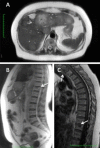Peripheral vision: abdominal pathology missed outside the centre of gaze
- PMID: 29927632
- PMCID: PMC6475938
- DOI: 10.1259/bjr.20180142
Peripheral vision: abdominal pathology missed outside the centre of gaze
Abstract
Radiology misses have been the subject of much debate on both sides of the Atlantic in recent years. There is now greater focus in trying to reduce radiology errors by continuous education and changing the working environment to try and protect the radiologist, and ultimately the patient from potential harm. Duty of candour is a relevant and sensitive area. Developing robust validated reporting pathways within the healthcare structure is very important so as to encourage a "learning from discrepancies" culture and to put the patient and their families at the center of reporting and acknowledging errors in radiology. Having reflected in our daily practice and while writing this pictorial review, we have concluded that during reporting MRI scans, routine assessment of the localizer images, focusing outside the area of interest and having a more structured approach to image interrogation are key actions which may help reduce the number of omissions. We present a myriad of cases where pathology was "missed" outside the center of gaze in relation to the abdomen or outside the abdomen on abdominal MRI, and suggest key high yield sequence related review areas to minimize the chance of missing potentially significant pathology.
Figures















References
Publication types
MeSH terms
LinkOut - more resources
Full Text Sources
Other Literature Sources

